

















AUTUMN APPLE WALNUT SALAD WITH MAPLE VINAIGRETTE
EMBRACING BLUEBERRIES
INTERGENERATIONAL LEARNING: FUN WAYS TO TEACH YOUR GRANDCHILDREN

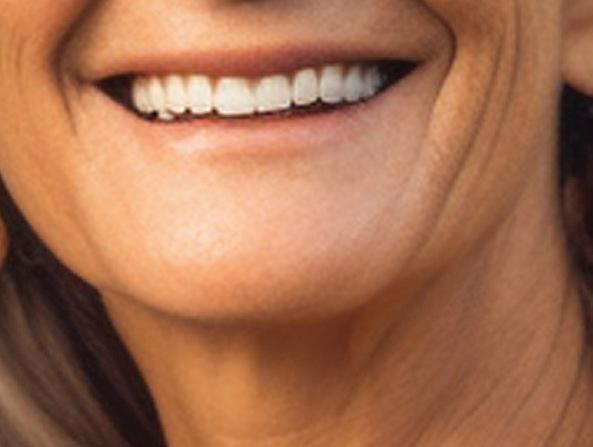























AUTUMN APPLE WALNUT SALAD WITH MAPLE VINAIGRETTE
INTERGENERATIONAL LEARNING: FUN WAYS TO TEACH YOUR GRANDCHILDREN









A SIMPLE & AFFORDABLE SKINCARE ROUTINE FOR A NATURAL GLOW
























SENIOR-FRIENDLY GARDEN PROJECTS DIY TIPS FOR
& MAINTENANCE
5. RECIPE Autumn Apple Walnut Salad With Maple Vinaigrette
7. RELATIONSHIPS
The Art of Active Listening to Strengthen Communication in Relationships
8. WELLNESS Your Fall Health Checkup The Importance of Regular Checkups and Screenings
10. NUTRITION Embracing Blueberries

11. RECIPE Blueberry Chia Pudding
12. RECIPE One-Pan Lemon Herb Chicken and Vegetables
14. GRANDCHILDREN
Intergenerational Learning: Fun Ways to Teach Your Grandchildren
24. FINANCE Are Exercise Classes Covered Under Medicare or Insurance?
26. EXERCISE Pilates: A Great Choice for Active Seniors
28. FUN Spot the 5 Differences
29. RECIPE Blueberry Lemon Mini Tart





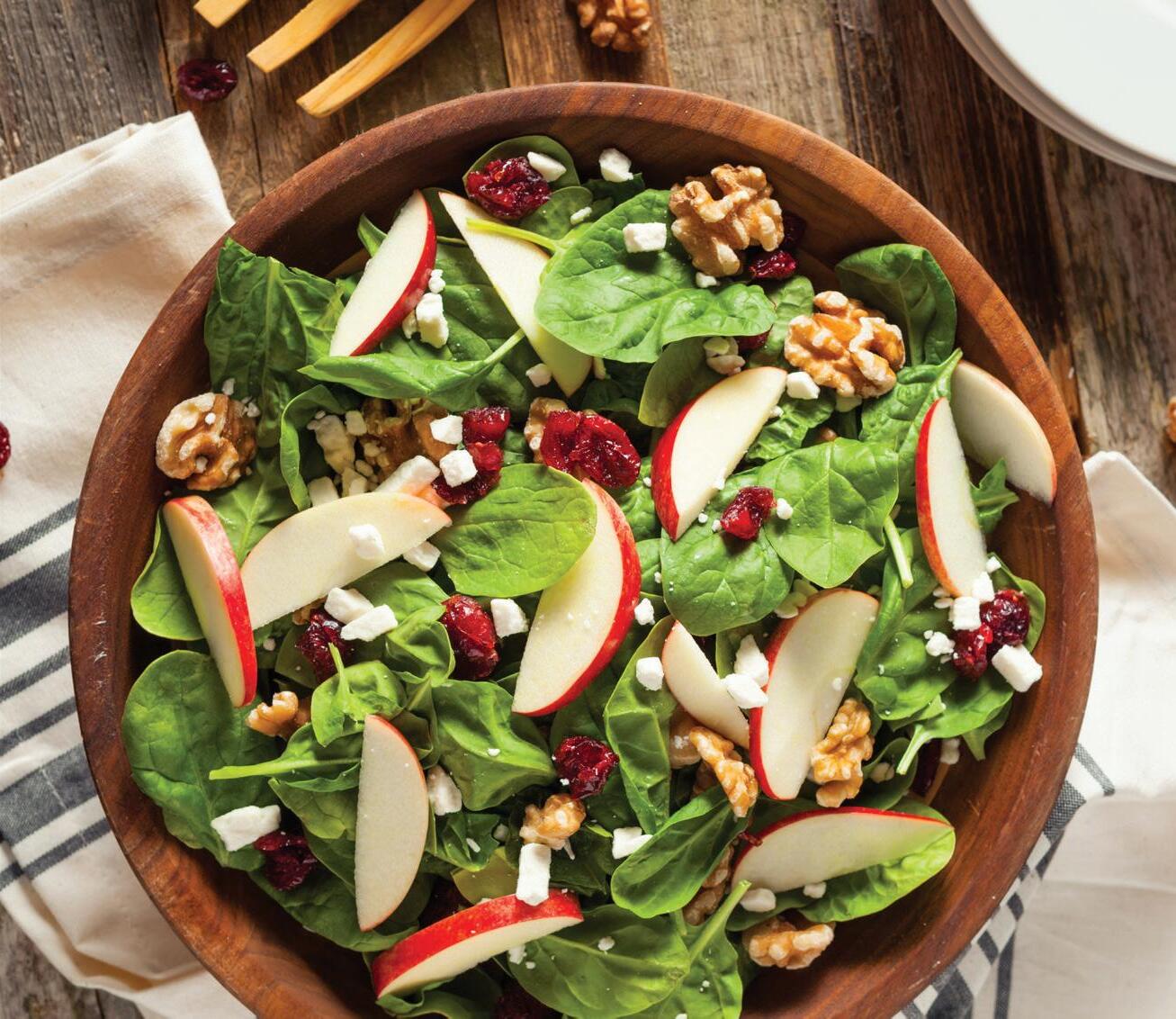








In a large salad bowl, combine the mixed greens, sliced apple, toasted walnuts, dried cranberries, crumbled cheese (if using), red onion and celery. Toss gently to mix all the ingredients evenly.



By Nellie Palmer






In a small bowl or jar with a lid, combine the extra-virgin olive oil, apple cider vinegar, pure maple syrup, Dijon mustard, salt and black pepper. Whisk vigorously or shake well until all the ingredients are emulsified and the dressing is smooth.


As the autumn leaves fall and the air turns crisp, it's the perfect time to enjoy seasonal produce. This Autumn Apple Walnut Salad is a delightful blend of flavors and textures, combining crisp apples, crunchy walnuts and a tangy-sweet maple vinaigrette. This recipe is tailored for one serving, making it an ideal, easy-to-prepare meal for seniors looking to enjoy a nutritious and flavorful dish.
INGREDIENTS
For Salad

• 2 cups mixed greens (such as arugula, spinach and romaine)
• 1 medium apple (Honeycrisp or Fuji), thinly sliced
• 1/4 cup walnut halves, toasted
• 2 tbsp dried cranberries
• 2 tbsp crumbled blue cheese or feta cheese (optional)
• 2 tbsp thinly sliced red onion
• 2 tbsp sliced celery
For Maple Vinaigrette
• 2 tbsp extra-virgin olive oil
• 1 tbsp apple cider vinegar
• 1 tbsp pure maple syrup
• 1/2 tsp Dijon mustard
• A pinch of salt





In a small skillet over medium heat, toast the walnut halves for about 5-7 minutes, stirring frequently until they are fragrant and lightly browned. Be careful not to burn them. Remove from the heat and let cool.
Wash and core the apple. Thinly slice it, leaving the skin on for added fiber and nutrition. If you’re not serving the salad immediately, you can toss the apple slices with a little lemon juice to prevent browning.



Drizzle the maple vinaigrette over the salad. Start with about half of the dressing, toss the salad gently, and then add more dressing to taste. It’s better to add the dressing gradually to avoid overdressing.
Transfer the salad to a plate and enjoy immediately.


FRESH AND SEASONAL:
For the best flavor, use fresh, seasonal apples and greens. Consider visiting a local farmers' market for THE FRESHEST PRODUCE.



HEALTHY EXTRAS: Add other nutritious ingredients like roasted butternut squash, pears, or a sprinkle of pomegranate seeds for extra flavor and color.



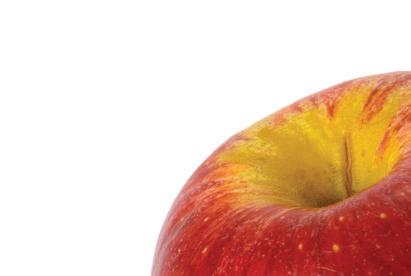
• A pinch of freshly ground black pepper
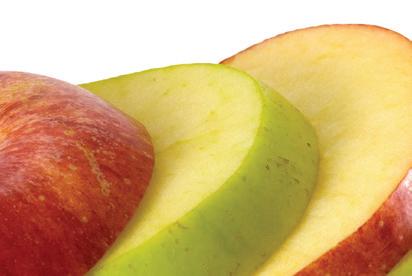










STORAGE: If you have extra dressing, store it in an airtight container in the refrigerator for up to a week. The salad is best enjoyed fresh.






executive publishers
Hal G. Fox & Suzanne Polk Fox
managing editor
Suzanne Polk Fox
copy editor
Christian Dischler
contributing writers
Jessie Gray
Alyssa Ingram
Nellie Palmer
Grant Parker
Catherine Spencer
Donna Strand art
design and production
Suzanne Fox
Claire Thomas
The information contained in Active Seniors is intended for educational purposes only. A reader should never substitute information contained in Active Seniors for the advice of a health care professional. Jumpstart Publishing, LLC and publishers of Active Seniors, do not endorse or promote any of the products or services described in the pages of Active Seniors and the publishers do not verify the accuracy of any claims made in the editorial or advertisements contained in Active Seniors. Readers should not use the information in Active Seniors for diagnosis or treatment of any health problem or for prescription of any medication or other treatment. Readers should consult with a healthcare professional before starting any diet, exercise or supplementation program, before taking any medication, or have or suspect they have a health problem.
©AS21-0624-0824 Fox Printing & Creative Publishing, LLC, New Orleans, LA All rights reserved Printed in the USA by Fox Print Services (igofox.com)





Effective communication is the cornerstone of healthy relationships, and active listening plays a pivotal role in fostering understanding, empathy and connection between individuals. Unlike passive hearing, active listening is a skill that requires intention, focus and genuine interest in what the other person is saying. Here are key principles to master the art of active listening and enhance communication in relationships.
Active listening begins with giving your full attention to the speaker. Eliminate distractions such as phones or television and maintain eye contact to signal your engagement and respect for their words. By showing attentiveness, you create a conducive environment where the speaker feels valued and understood.
Resist the urge to interrupt or interject with your own thoughts while the other person is speaking. Allow them to express their thoughts and feelings fully before
offering your perspective. This demonstrates respect for their viewpoint and encourages open dialogue without feelings of being rushed or unheard.
Empathy is a cornerstone of active listening. Seek to understand the speaker's emotions and perspectives from their point of view. Reflect their feelings back to them to confirm understanding, using phrases like, "It sounds like you're feeling…" or "I understand that you're concerned about…"
To ensure clarity and demonstrate your interest in their thoughts, ask open-ended questions that encourage elaboration. Clarifying questions can help you delve deeper into their concerns or feelings, showing that you value their input and want to fully comprehend their perspective.
Throughout the conversation, periodically paraphrase what you've heard to confirm accuracy
By Alyssa Ingram
and show active engagement. Summarize key points to demonstrate your understanding of their message and to ensure that both parties are on the same page.
After actively listening and understanding the speaker's viewpoint, respond thoughtfully and respectfully. Acknowledge their feelings and perspectives even if you may not agree with them. Responding with empathy and consideration fosters a supportive environment where both parties feel heard and valued. Mastering the art of active listening is essential for strengthening communication in relationships. By practicing these principles you can build stronger connections, enhance mutual understanding and foster a deeper sense of trust and respect in your relationships. Active listening not only improves communication but also creates a supportive and nurturing environment where both parties feel validated and valued, ultimately enriching the quality of relationships in profound and meaningful ways.






By Donna Strand

s the leaves change color and the air turns crisp, fall presents an ideal time to focus on your health. Regular check-ups and screenings are crucial for maintaining well-being, detecting potential health issues early and ensuring that you are on the right track with your health goals. Here’s a comprehensive guide to the importance of regular health check-ups and screenings, and what you should have checked annually versus more frequently.


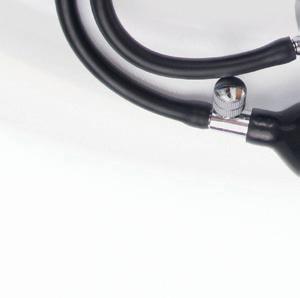


Regular health check-ups are essential for several reasons:
Early Detection of Diseases: Many health issues, including cancer, diabetes and heart disease, can develop silently without noticeable symptoms. Regular screenings can detect these conditions early, when they are most treatable.






During an annual check-up, your healthcare provider will typically perform a comprehensive evaluation, including:
Physical Examination: A thorough physical exam to assess overall health and detect any abnormalities.

Blood Pressure Check:

Preventive Care: Check-ups are a proactive way to stay ahead of potential health problems. Vaccinations, lifestyle advice and preventive screenings help keep illnesses at bay.
High blood pressure is a major risk factor for heart disease and stroke, often with no symptoms.













Management of Chronic Conditions: For those with chronic illnesses such as hypertension or diabetes, regular visits to the doctor are crucial for monitoring and managing these conditions effectively.


Blood Tests: These can include a complete blood count (CBC), cholesterol levels, blood glucose levels and liver and kidney function tests.
BMI and Weight Check: Monitoring weight and body mass index (BMI) to prevent obesity-related conditions.




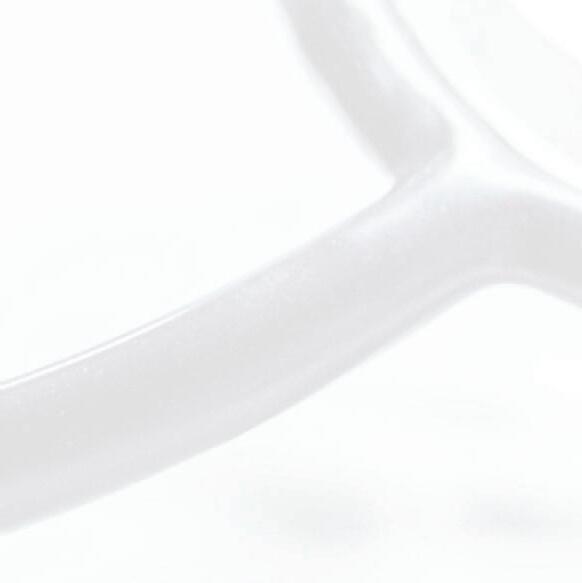




Updating Medical Records: Regular visits ensure that your medical records are up to date, providing an accurate history for any future medical needs.
Vaccinations: Keeping up with vaccines such as the flu shot, tetanus booster and others as recommended.
Cancer Screenings: Depending on age and risk factors, this may include mammograms, Pap smears, colonoscopies or prostate exams.







Certain health parameters should be checked more frequently than annually, particularly if you have specific risk factors or ongoing health concerns:
Blood Pressure: For those with hypertension or at risk of heart disease, blood pressure should be monitored more frequently, possibly at home.

Weight and BMI: Regular monitoring can help manage and prevent obesity-related health issues.


Mental Health: Regular check-ins with a mental health professional are important, especially if you experience anxiety, depression or other mental health issues.
Family Health History: Update any changes in your family’s health history, as this can impact your risk factors.
Healthy Lifestyle: Discuss diet, exercise and lifestyle habits with your doctor to get tailored advice.

Blood Sugar Levels: Diabetics or those at risk of diabetes should regularly check their blood sugar levels to manage and prevent complications.
Cholesterol Levels: If you have high cholesterol or are at risk for cardiovascular disease, your doctor may recommend more frequent lipid panel tests.


To make the most of your annual health check-up:

List Your Concerns: Write down any symptoms or health concerns you have noticed since your last visit.















Stay ahead of your health with your annual check-up. Fall is a perfect time to schedule your appointment, ensuring you are proactive in your health care. By staying vigilant about both annual and more frequent health checks, you can enjoy a healthier, more vibrant life. care. By staying vigilant about














Medication Review: Bring a list of all medications, including supplements, that you are taking.


























































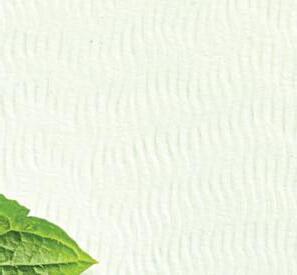






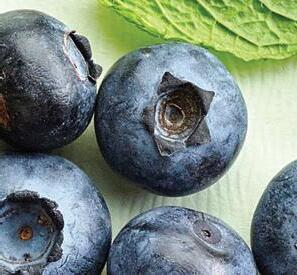

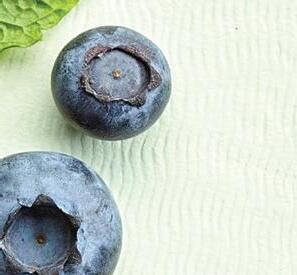




By Alyssa Ingram


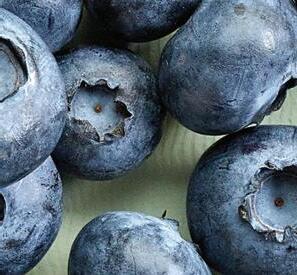



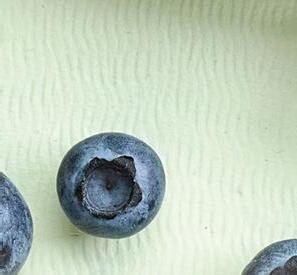





n a world of healthy eating, few foods boast the nutritional prowess and the delightful flavor profile of blueberries. These tiny, vibrant berries pack a powerful punch when it comes to promoting overall well-being and vitality. Whether enjoyed fresh, frozen or incorporated into various dishes, blueberries are a versatile super food that can easily elevate your daily diet. Blueberries are celebrated for their rich antioxidant content, particularly from compounds known as anthocyanins, which give them their deep blue color. These antioxidants play a crucial role in combating oxidative stress and inflammation in the body, potentially reducing the risk of chronic diseases such as heart disease, diabetes and


certain cancers. Additionally, blueberries are low in calories but high in fiber, making them a satisfying snack choice that supports digestive health and helps maintain a healthy weight. Regular consumption of blueberries has been linked to several health benefits, including improved cognitive function and memory. Studies suggest that the antioxidants in blueberries may protect brain cells from oxidative stress and inflammation, potentially delaying the onset of agerelated cognitive decline. Furthermore, the fiber content in blueberries supports heart health by helping to lower cholesterol levels and improve blood pressure regulation.

Incorporating blueberries into your daily diet is effortless and delicious. Here are a few simple ideas to incorporate this super food into your meals:
Breakfast: Add fresh blueberries to your morning cereal, oatmeal or yogurt for a burst of sweetness and nutrition.
Snacks: Enjoy a handful of fresh blueberries as a refreshing snack on their own or mixed with nuts for a satisfying trail mix.
Smoothies: Blend blueberries with yogurt, spinach and a banana for a nutritious and antioxidant-rich smoothie.
Salads: Toss fresh blueberries into green salads with nuts, seeds and a light vinaigrette for a flavorful and nutritious twist.


















Desserts: Use blueberries in baking muffins, pancakes or cobblers for a naturally sweet and healthy treat.




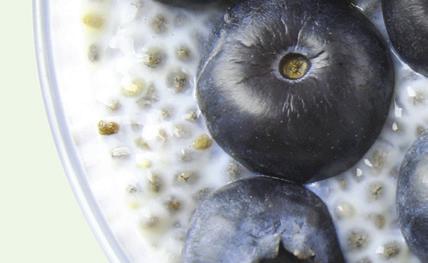

INGREDIENTS
• 1 cup fresh or frozen blueberries
• 1 cup unsweetened almond milk (or milk of choice)
• 1/4 cup chia seeds
• 1 tbsp honey or maple syrup (optional, for sweetness)
• 1/2 tsp vanilla extract
DIRECTIONS
In a blender, combine the blueberries, almond milk, honey or maple syrup (if using), and vanilla extract. Blend until smooth.

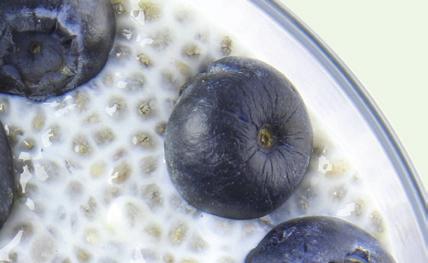

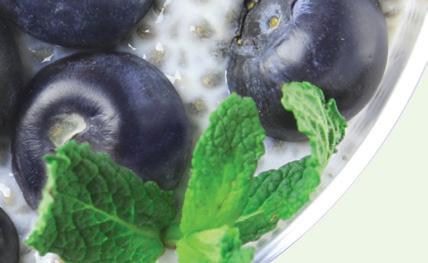




Pour the blended mixture into a bowl or jar. Stir in the chia seeds until well combined.
Cover the bowl or jar and refrigerate for at least 4 hours or overnight, until the chia seeds have absorbed the liquid and the mixture has thickened to a pudding-like consistency.
Serve the blueberry chia pudding chilled, topped with additional fresh blueberries or your favorite nuts and seeds for added crunch.
Whether you're looking to boost your antioxidant intake, support heart health, or simply indulge in a delicious and nutritious snack, blueberries are an excellent choice. By incorporating these vibrant berries into your daily meals and snacks, you can reap the benefits of their nutritional value while delighting in their natural sweetness and versatility. Embrace the power of blueberries and savor the goodness they bring to your health and well-being with every bite.















By Nellie Palmer &



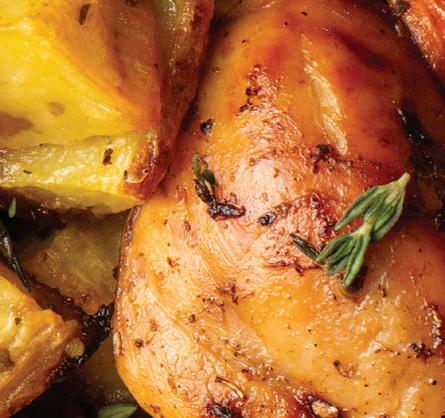


THIS ONE-PAN LEMON HERB CHICKEN AND VEGETABLES RECIPE IS PERFECT FOR SENIORS COOKING FOR TWO. IT'S SIMPLE, BUDGET-FRIENDLY, AND USES EASY-TO-FIND INGREDIENTS. PLUS, IT ALL COOKS IN ONE PAN, MAKING CLEANUP A BREEZE.
INGREDIENTS
• Chicken pieces—legs, thighs
• 1 cup baby potatoes, halved
• 1 cup baby carrots
• 2 tbsp olive oil
• 1 lemon (zested and juiced)
• 2 cloves garlic, minced
• 1 tsp dried oregano
• 1 tsp dried thyme
• Salt and pepper to taste
• Fresh rosemary for garnish (optional)
Preheat your oven to 400°F (200°C).
In a small bowl, combine the olive oil, lemon zest, lemon juice, minced garlic, dried oregano, dried thyme, salt and pepper.
Place the chicken in a large bowl or a zip-top bag. Pour half of the marinade over the chicken and let it sit for at least 15 minutes (or up to an hour if you have time).

In a large bowl, toss the potatoes and carrots with the remaining marinade.
Arrange the marinated chicken pieces in a casserole dish. Spread the vegetables


around the chicken in an even layer.

Place the casserole in the preheated oven and bake for 25-30 minutes, or until the chicken is cooked through (internal temperature should reach 165°F or 74°C) and the vegetables are tender.
Garnish with fresh rosemary if desired and serve hot.
• Vegetable Substitutes: Feel free to use other budgetfriendly vegetables like bell peppers, zucchini or broccoli.
• Chicken Breasts: If you prefer, you can use boneless, skinless chicken breasts instead of dark meat.


• Meal Prep: Marinate the chicken and prepare the vegetables ahead of time for an even quicker meal.
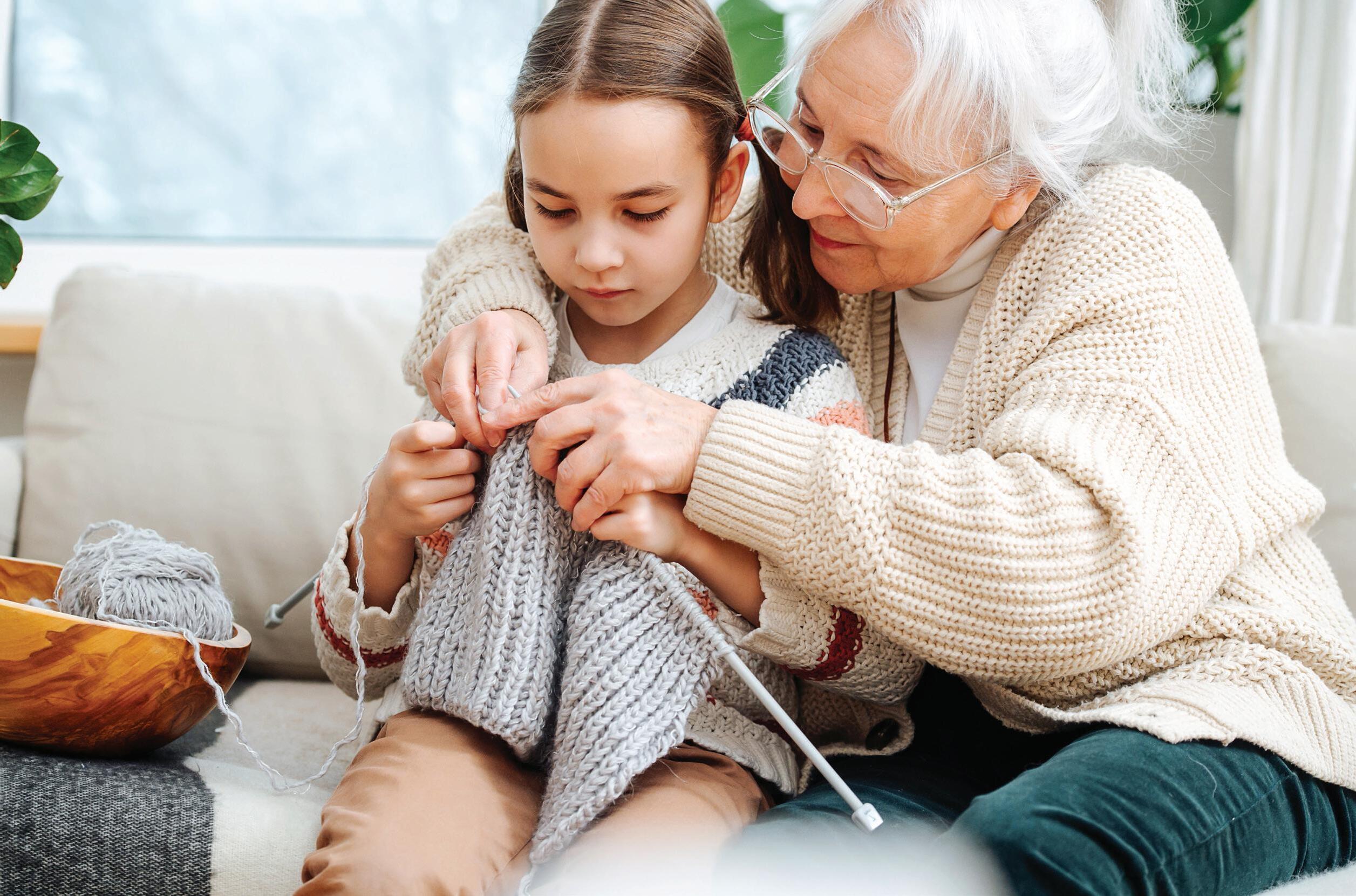








Intergenerational learning is a collaborative process where knowledge, skills and values are exchanged between different generations. This approach not only fosters a deep sense of connection and understanding but also leverages the unique perspectives and experiences each generation brings to the table. Grandparents, play a vital role in this dynamic, offering a wealth of wisdom and life skills that transcend technological advances. They often bring the simple logic and joys of childhood before the era of electronics, enriching their grandkids’ lives in countless ways.
One of the core principles of intergenerational learning is the mutual benefit it offers.
By Grant Parker
Grandchildren gain insights into their heritage, practical skills and timeless wisdom, while grandparents stay engaged, active and emotionally fulfilled. This exchange can take many forms, from storytelling and traditional crafts to gardening and cooking. Each activity not only teaches valuable lessons but also strengthens the bond between generations.
Storytelling is a powerful tool in intergenerational learning. Grandparents can share tales from their own childhood, recounting family history, cultural traditions and personal experiences. These stories not only entertain but also impart moral lessons and historical knowledge, helping

grandchildren develop a sense of identity and continuity. Listening to how life was before the digital age, kids learn to appreciate the simplicity and creativity of earlier times.
Engaging in traditional crafts such as knitting, woodworking or sewing can be both fun
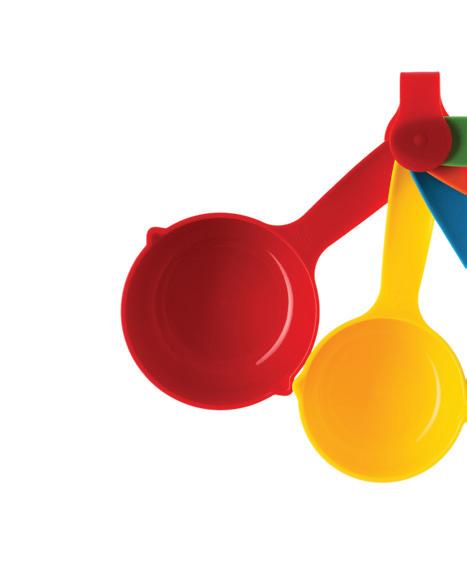

and educational. These activities teach patience, dexterity and creativity. Grandparents can pass down these skills, often learned from their own parents or grandparents, ensuring that such valuable knowledge is not lost. These sessions can be particularly rewarding as they produce tangible results, whether it's a handmade scarf or a wooden birdhouse, giving children a sense of accomplishment and pride.
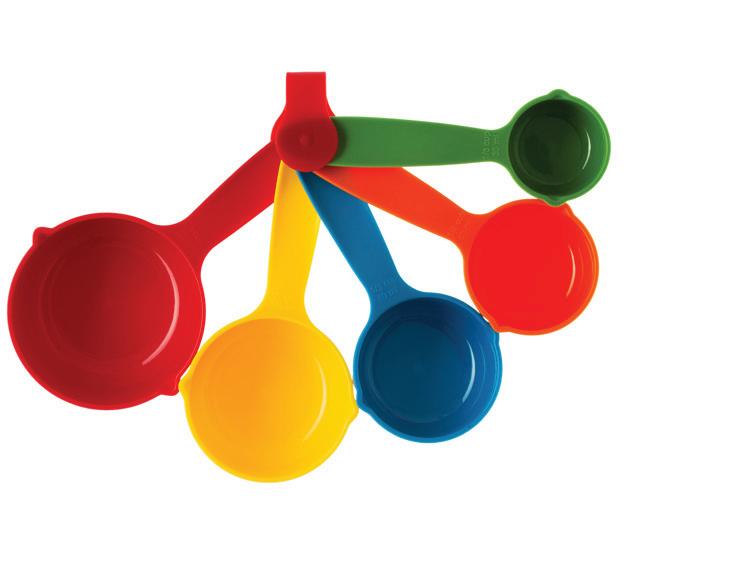



Gardening offers a practical and rewarding way to share knowledge. From planting seeds to harvesting vegetables, grandparents can teach grandchildren about the cycles of nature, the importance of sustainability and the joys of growing one’s own food. These activities encourage kids to spend time outdoors, fostering a love for nature and physical activity, away from screens and gadgets.
Cooking and baking are wonderful intergenerational activities that combine fun and learning. Grandparents can share family recipes, teach cooking techniques and impart nutritional wisdom. Cooking together also enhances math skills through measuring ingredients and improves reading skills by following recipes. Plus, it results in delicious rewards that can be enjoyed together.
Classic board games, card games and puzzles are fantastic for cognitive development and bonding. Games like chess, checkers or card games teach strategic thinking, patience and sportsmanship. These activities can be a refreshing break from digital games, showing children the joys of traditional forms of entertainment.
Intergenerational learning is a rich, multifaceted approach that benefits both grandparents and grandchildren. By sharing stories, skills and activities, grandparents provide their grandkids with a valuable education that goes beyond the classroom. They bring the essence of a simpler, more tactile childhood, helping children to develop a well-rounded perspective that includes both the wisdom of the past and the innovations of the present.

















SKINCARE REGIMEN FOR A HEALTHY GLOW
Gentle Cleansing: Start with a gentle, hydrating cleanser to remove impurities without stripping your skin of its natural oils. Look for cleansers with ingredients like glycerin or hyaluronic acid.
Recommendation: CeraVe Hydrating Facial Cleanser
Exfoliation: Exfoliate once or twice a week to remove dead skin cells and promote cell turnover. Opt for a mild chemical exfoliant containing alpha-hydroxy acids (AHAs) or beta-hydroxy acids (BHAs) instead of harsh scrubs.

Recommendation: The Ordinary Glycolic Acid 7% Toning Solution








By Alyssa Ingram
AS WE AGE, OUR SKIN AND BEAUTY NEEDS EVOLVE. A WELL-CRAFTED SKINCARE REGIMEN AND A MINIMALIST MAKEUP APPROACH CAN HELP MAINTAIN A HEALTHY, RADIANT GLOW WITHOUT BREAKING THE BANK. HERE’S A GUIDE TO ACHIEVING YOUTHFUL SKIN AND A NATURAL MAKEUP LOOK THAT ENHANCES YOUR BEAUTY RATHER THAN MASKING IT.
Hydration: Keep your skin hydrated with a good moisturizer. Ingredients like hyaluronic acid, glycerin and ceramides help retain moisture and strengthen the skin barrier.
Recommendation: Neutrogena Hydro Boost Water Gel
Sun Protection: Protect your skin from UV damage by applying a broad-spectrum sunscreen with at least SPF 30 daily, even on cloudy days. Sunscreen helps prevent age spots, wrinkles and skin cancer.

Recommendation: La RochePosay Anthelios Melt-in Milk Sunscreen SPF 60
aging and peptides for firming. Use these treatments according to your skin’s needs.
Recommendation: The Ordinary Ascorbyl Glucoside Solution 12% (Vitamin C) and Olay Regenerist Retinol 24 Night Serum

Targeted Treatments:
Incorporate serums with active ingredients like vitamin C for brightening, retinoids for anti-




It's equally important for men to have a dedicated skincare regimen to maintain healthy, resilient skin. While the fundamental steps are similar to those for women, there are a few adjustments to consider based on skin type, lifestyle and shaving needs.



Cleansing: Men generally have thicker, oilier skin and larger

pores, making cleansing crucial. A good cleanser can help prevent breakouts and ingrown hairs.
Recommendation: CeraVe
Foaming Facial Cleanser
Exfoliation: Regular exfoliation is vital for removing dead skin cells and reducing ingrown hairs, especially for those who shave frequently. Exfoliate 2-3 times a week with a gentle scrub or chemical exfoliant.
Recommendation: Neutrogena Men Skin Clearing Acne Wash
Moisturizing: Hydration is key. Men should use a lightweight, non-greasy moisturizer that absorbs quickly, providing hydration without clogging pores.
Recommendation: Jack Black
Double-Duty Face Moisturizer SPF 20
Sun Protection: Sunscreen is essential for preventing premature aging and skin cancer. Men often neglect this step, but a broad-spectrum SPF is a must.
Recommendation: Neutrogena Men Triple Protect Face Lotion SPF 20
Post-Shave Care: Shaving can cause irritation and dryness. Using a soothing aftershave balm can help calm the skin and prevent razor burn.
Recommendation: Nivea Men Sensitive Post Shave Balm
As men age, their skin undergoes changes similar to women’s, such as loss of elasticity, increased dryness and the appearance of wrinkles.

Incorporate Anti-Aging
Products: Use retinoids, vitamin C serums, and products with peptides to boost collagen production and reduce fine lines.


Recommendation: The Ordinary Retinol 0.5% in Squalane

Focus on Hydration: Aging skin tends to be drier, so using richer moisturizers at night can help maintain skin barrier function and hydration.
Recommendation: CeraVe PM Facial Moisturizing Lotion
Regular Dermatologist Visits: Routine check-ups with a dermatologist can help manage age-related skin issues and





monitor for skin cancer, which men are more prone to.

Primer: Start with a lightweight primer to create a smooth base for your makeup. Choose a hydrating formula to give your skin a dewy finish.
Recommendation: e.l.f.
Hydrating Face Primer Foundation: Use a sheer, buildable foundation or a tinted moisturizer to even out your skin tone without looking cakey. Apply sparingly and blend well.
Recommendation:
Maybelline Fit Me Dewy + Smooth Foundation
Concealer: Apply a creamy concealer to cover dark circles, age spots and any blemishes. Dab lightly and blend with your fingertips or a sponge for a natural finish.
Recommendation:
Maybelline Instant Age
Rewind Eraser Dark Circles Concealer
Blush and Bronzer: Opt for cream blush and bronzer for a natural, luminous glow. Apply blush to the apples of your cheeks and blend upwards. Use bronzer sparingly along the hairline, jawline and
cheekbones for subtle contouring.
Recommendation: e.l.f. Cream Blush Palette and Physicians Formula
Murumuru Butter Bronzer
Eyes: Keep eye makeup simple. Use neutral shades to enhance your eyes without overpowering them. A touch of mascara and a light application of eyeliner can open up your eyes.
Recommendation:
L'Oréal Paris
Voluminous Lash Paradise Mascara and NYX Professional Makeup Retractable Eyeliner
Brows: Fill in sparse brows with a brow pencil or powder. Stick to your natural brow shape and avoid over-filling.
Recommendation:
NYX Professional Makeup Micro Brow Pencil
Lips: Choose moisturizing lipsticks or tinted balms in natural shades. Avoid heavy matte formulas that can settle into fine lines.
Recommendation:
Burt’s Bees Tinted Lip Balm

Less is More: Apply makeup sparingly and blend thoroughly to avoid a heavy, mask-like appearance. The goal is to enhance your natural features.
Hydration is Key: Ensure your skin is well-hydrated before applying makeup to prevent it from settling into fine lines and wrinkles.
Light Layers: Apply makeup in light layers, building coverage gradually if needed. This helps achieve a more natural look.
Blend, Blend, Blend: Use your fingers, brushes or sponges to blend makeup seamlessly into your skin. This prevents harsh lines and creates a smooth finish.
Natural Light: Apply makeup in natural light to get a true sense of how it will look in different settings.
By following these skincare and makeup tips, you can maintain a healthy, youthful glow that highlights your natural beauty. Remember, aging gracefully is all about embracing your features and caring for your skin in a way that makes you feel confident and radiant.

By Grant Parker
As the vibrant colors of summer begin to fade, fall emerges as an ideal time to engage in gardening projects that enhance both the beauty and functionality of your outdoor space. With cooler temperatures and a more manageable workload, autumn presents a golden opportunity for seniors to enjoy gardening activities that promote physical activity, mental well-being and the joy of cultivating nature.
For seniors who may face mobility challenges or prefer not to bend over for extended periods, raised beds offer a practical solution.
These elevated garden plots can be constructed from various materials such as wood, bricks or even composite materials, providing a customizable height that minimizes strain on the back and knees. Fall is an excellent time to prepare raised beds for planting by adding compost, mulch and organic matter to enrich the soil and ensure healthy plant growth come spring.
Container gardening is another versatile option for seniors, allowing them to cultivate plants in pots or containers placed strategically around patios, balconies or even indoors near windows. This method
offers flexibility in terms of plant selection and placement, making it easier to care for and move plants as needed. In the fall, seniors can refresh their container gardens by replacing summer annuals with resilient fall blooms like chrysanthemums or ornamental kale, bringing seasonal color to their outdoor spaces.
3.PATHWAY AND GARDEN BED MAINTENANCE:
Maintaining clear pathways and garden beds is essential for preventing slips and falls, especially as leaves begin to accumulate. Seniors can use lightweight tools such as ergonomic rakes or leaf blowers to clear debris from walkways and around


garden beds, ensuring safe passage and reducing the risk of accidents. Additionally, defining garden bed edges with durable materials like stone or plastic landscape edging helps contain mulch and soil, creating a tidy and organized appearance that is easier to maintain.
Efficient watering systems are crucial for maintaining plant health without excessive physical strain. Consider hiring someone to install soaker hoses or drip irrigation systems in your garden to ensure that plants receive

consistent moisture directly at heir roots while minimizing water waste and the need for manual watering. Seniors can also use lightweight watering cans or hose attachments with adjustable nozzles to water plants effectively while conserving energy and reducing the risk of overexertion.
Fall is an opportune time for pruning trees, shrubs and perennial plants to promote healthy growth and maintain their shape. Seniors can use bypass pruners or





ADloppers with ergonomic handles for easier cutting and reduced hand strain. Removing dead or diseased branches not only enhances the appearance of the garden but also prevents potential hazards during winter storms. Collecting and composting fallen leaves and plant debris contributes to sustainable garden practices while keeping outdoor spaces neat and orderly.






Creating wildlifefriendly features such as bird feeders, butterfly gardens or bee-friendly plants adds vibrancy and ecological diversity to senior-friendly gardens. Installing birdhouses or placing feeders at accessible heights allows seniors to enjoy the sights and sounds of visiting birds without difficulty. Choosing native plants that attract pollinators like butterflies and bees not only enhances the garden's aesthetic appeal but also supports local ecosystems, fostering a harmonious balance between nature and garden enjoyment.
amid the natural surroundings.
Investing in lightweight, ergonomic gardening tools and equipment can significantly enhance comfort and safety for senior gardeners. Tools with cushioned grips and extended handles reduce strain on joints and muscles, making tasks such as planting, weeding and pruning more manageable and enjoyable. Additionally, using wheeled garden carts or kneelers with handles provides support and stability during activities that require kneeling or bending, ensuring seniors can garden comfortably for longer periods.

Creating inviting seating areas within the garden allows seniors to take breaks, admire their handiwork and connect with nature. Placing benches or chairs on stable surfaces near focal points such as flower beds or water features provides a comfortable spot to rest and enjoy the beauty of the garden. Incorporating shade umbrellas or pergolas with climbing plants like vines or roses enhances privacy and creates a tranquil retreat for relaxation and reflection
With each season, the garden becomes a testament to the joy and fulfillment that gardening brings to individuals of all ages, especially those who cherish the beauty and tranquility of their senior-friendly outdoor retreats.
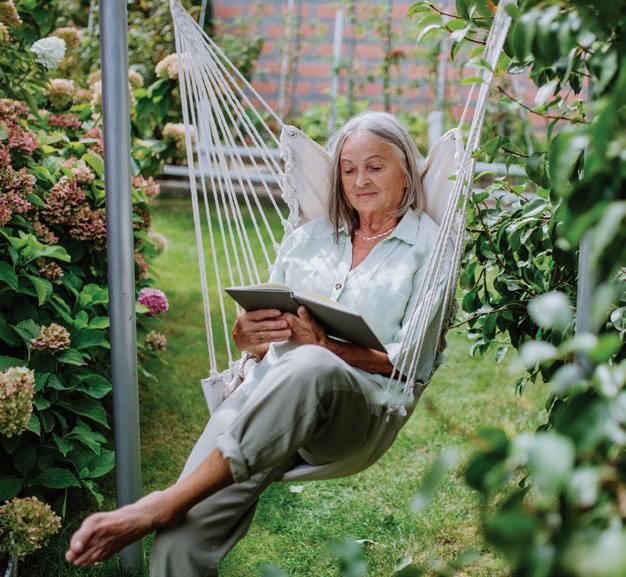
By Catherine Spencer
As we age, staying active and managing chronic health conditions becomes increasingly important. Exercise classes can provide a structured and enjoyable way to maintain physical fitness, while hot tubs offer therapeutic benefits for those dealing with conditions such as arthritis and chronic pain. However, the costs associated with these wellness activities can add up, leading many seniors to wonder if Medicare or private insurance plans will cover these expenses.
Navigating the complexities of insurance coverage for exercise programs and therapeutic equipment like hot tubs can be challenging, but understanding your options can help you make informed decisions about your health and well-being.
Coverage for exercise classes under Medicare or insurance plans can vary significantly based on several factors, including the specific plan and the nature of

ARE EXERCISE CLASSES COVERED UNDER MEDICARE OR INSURANCE? ARE EXERCISE CLASSES COVERED UNDER MEDICARE OR INSURANCE?
the exercise program. Here's a general overview of what you can expect:
Exercise Classes and Fitness Centers
Medicare typically does not cover fitness programs like gym memberships or exercise classes under its Original Medicare (Part A and Part B) plans. However, there are some exceptions:
1. Medicare
Advantage (Part C): Some Medicare Advantage plans may offer additional benefits, including fitness programs, gym memberships and wellness programs. These plans are provided by private insurance companies and can vary widely in terms of coverage and availability. It’s worth checking with
your specific Medicare Advantage provider to see if they include benefits for exercise classes.
2. Medicare Supplemental Insurance (Medigap): Medigap plans usually do not cover exercise classes, as they are designed to help cover out-of-pocket costs not covered by Original Medicare, such as copayments, coinsurance and deductibles.
Coverage for exercise classes under private insurance plans can also vary:
1. EmployerSponsored Plans:
Some employersponsored health insurance plans may offer wellness programs, which can include discounts or reimbursements for
gym memberships and fitness classes. It's advisable to check with your employer's human resources department or your insurance provider for specific details.
2. Individual Health Insurance Plans: If you have an individual health insurance plan, coverage for fitness programs will depend on the specifics of your policy. Some plans may include wellness benefits or offer discounts on fitness programs.
If you have a Flexible Spending Account (FSAs) or Health Savings Account (HSAs), you might be able to use these funds to pay for exercise programs if a doctor prescribes them for a specific medical condition.
For example, if you have a condition like
osteoporosis or chronic back pain and your doctor recommends an exercise program as part of your treatment plan, you may be able to use FSA or HSA funds to cover the cost.
How to Find Out if You’re Covered
1. Review Your Plan Documents: Look at your insurance policy details or your Medicare Advantage plan documents to see if wellness benefits are included.
2. Contact Your Insurance Provider: Call your insurance provider's customer service number to ask about coverage for fitness programs and any required documentation or referrals.
3. Speak with Your Doctor: If you have a medical condition that could benefit from an exercise program, ask your doctor if they can provide a prescription or recommendation that might help with coverage or reimbursement.
Hot Tubs
Coverage for hot tubs under Medicare or insurance plans can be quite limited and is usually considered on a case-by-case basis. Generally, hot tubs are classified as comfort items rather than medical necessities, which makes them less likely to be covered. However, there are scenarios where coverage might be possible:
1. Medical Necessity:
If a doctor prescribes a hot tub as a necessary treatment for a medical condition, such as severe arthritis or chronic pain, it may be considered for coverage. Documentation from a healthcare provider stating that the hot tub is essential for the patient’s treatment can help in this case.
2. Medicare: Original Medicare typically does not cover hot tubs. Some Medicare Advantage plans might offer additional wellness benefits, but

coverage for hot tubs is rare.
3. Private Insurance:
Similar to Medicare, private insurance plans generally do not cover hot tubs unless they are deemed medically necessary. It’s important to check with your insurance provider and provide thorough documentation from your doctor to support your claim.
4. FSAs and HSAs: You might be able to use FSA or HSA funds for a hot tub if it is prescribed by a doctor for a specific medical condition. This would require a Letter
of Medical Necessity (LMN) from your healthcare provider. While coverage for exercise classes and hot tubs under Medicare or insurance can be limited, it's important to explore your options and discuss them with your healthcare providers and insurance representatives. By understanding your plan's benefits and following the necessary steps to obtain documentation, you may find ways to reduce your out-of-pocket costs and enhance your overall wellness.




By Catherine Spencer
As we age, maintaining physical fitness becomes increasingly important for our overall health and well-being. For active seniors, finding an exercise routine that is both effective and enjoyable can make a significant difference in quality of life. Pilates, a low-impact workout developed by Joseph Pilates in the early 20th century, is an excellent choice for seniors looking to improve stamina, build muscle and maintain mobility. Incorporating Pilates into your routine can lead to a stronger, more flexible and balanced body, enhancing your ability to enjoy an active lifestyle for years to come.
A Pilates reformer is a piece of exercise equipment designed to enhance the Pilates workout. It consists of a flat platform called the carriage, which moves back and forth along a frame using a series of springs for resistance. The carriage is attached to adjustable straps and a foot bar, allowing users to perform a wide variety of exercises targeting different muscle groups. The reformer's unique design enables smooth, controlled movements










that can be easily modified to accommodate various fitness levels and physical abilities, making it an ideal tool for both beginners and advanced practitioners.
For seniors interested in starting Pilates, finding the right class is essential to ensure safety and effectiveness. Begin by researching local fitness centers, community centers and specialized Pilates studios that offer classes tailored to seniors. Many facilities provide beginner-friendly sessions and modifications for different ability levels. It's also helpful to read reviews and ask for recommendations from friends or healthcare providers. When you find a potential class, consider visiting the studio to meet the instructor and observe a session. Look for certified instructors with experience working with seniors, as they can provide personalized guidance and support. Additionally, some studios offer introductory packages or free trial classes,







which can be a great way to determine if Pilates is the right fit for you.
The four reformer moves that are particularly beneficial for seniors focus on strengthening your back and legs to keep you mobile and your upper body to help improve posture which is important as we age.
Footwork on the Pilates reformer is a fundamental exercise that targets the legs and core, helping to build strength and endurance. This exercise involves lying on the reformer with feet placed on the foot bar and performing controlled leg presses. Footwork helps improve circulation, strengthen the muscles around the knees and hips and enhance overall leg strength, which is crucial for mobility and balance.
Benefits:
• Enhances lower body strength and stability
• Improves blood circulation
• Supports knee and hip joint health



Leg circles are excellent for improving hip mobility and strengthening the core muscles. This exercise involves lying on the reformer and making circular motions with one leg at a time while the other leg remains stationary. Leg circles help maintain flexibility in the hip joints and build strength in the abdominal muscles, which are essential for a strong and stable back.
Benefits:
• Increases hip joint flexibility
• Strengthens core muscles
• Enhances coordination and balance
Bridging on the reformer focuses on the glutes, hamstrings and lower back. This exercise
is performed by lying on the reformer and lifting the hips towards the ceiling, creating a bridge shape with your body. Bridging helps strengthen the posterior chain, improves spinal mobility and enhances balance. Benefits:
• Strengthens glutes and hamstrings
• Improves spinal flexibility
• Enhances pelvic stability
Rowing back on the reformer targets the upper back, shoulders and arms, which are essential for maintaining good posture and preventing back pain. This exercise involves sitting on the reformer, holding the straps and performing a rowing motion. It helps strengthen the muscles that support the spine and improve
overall upper body strength. Benefits:
• Strengthens upper back and shoulders
• Improves posture
• Enhances arm strength and stability
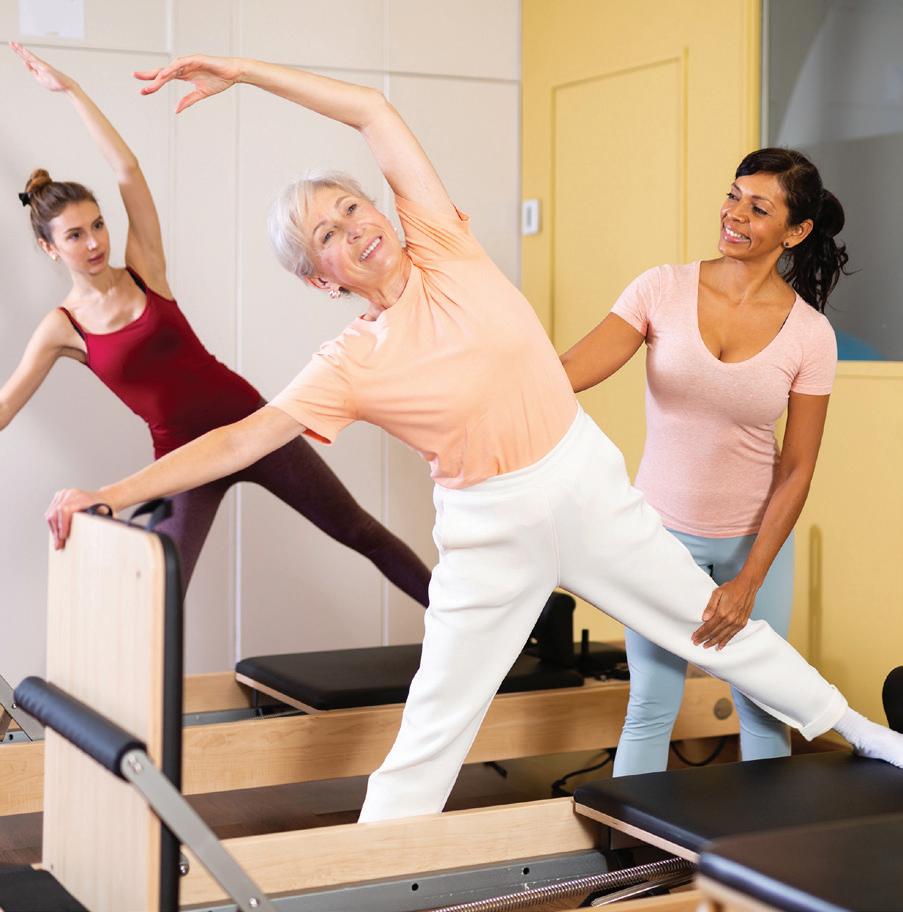




























































(3) Backpack and gear behind camper door. (4) Vase of fl owers on table.
Answer Key: (1) OWL!!ß (2) Cat sitting in window.
By Jessie Gray





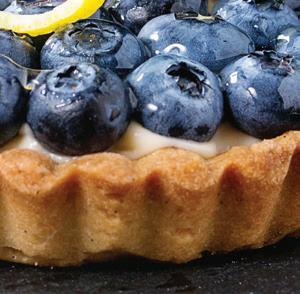






INGREDIENTS
For the Crust:
• 1 1/2 cups graham cracker crumbs
• 1/4 cup granulated sugar
• 1/2 cup unsalted butter, melted
DIRECTIONS
1. Prepare the Crust:
◦ Preheat your oven to 350°F (175°C).
◦ In a medium bowl, combine the graham cracker crumbs and granulated sugar.
◦ Add the melted butter and mix until the crumbs are evenly coated.
◦ Press the mixture into the bottoms and sides of mini tart pans or a standard muffin tin lined with paper liners.
◦ Bake for 8-10 minutes, until the crust is lightly golden. Let cool completely.
2. Make the Blueberry Filling:
◦ In a medium saucepan, combine the blueberries, granulated sugar, cornstarch, water, lemon juice and lemon zest.

For the Filling:
• 2 cups fresh or frozen blueberries
• 1/4 cup granulated sugar
• 2 tbsp cornstarch
• 1/4 cup water
◦ Remove from heat and let cool to room temperature.
3. Prepare the Whipped Cream:
• 1 tbsp lemon juice
• 1 tsp lemon zest

These Blueberry Lemon Mini Tarts are a delightful and easy-to-make dessert, perfect for entertaining friends in the fall. They combine the fresh taste of blueberries with a hint of lemon, offering a refreshing and elegant treat.

◦ In a large bowl, beat the heavy whipping cream, powdered sugar, and vanilla extract until soft peaks form.
4. Assemble the Tarts:
◦ Spoon the cooled blueberry filling into the prepared crusts.
◦ Top each tart with a dollop of whipped cream.
5. Serve:
◦ Garnish with a few fresh blueberries and a sprinkle of lemon zest, if desired.
◦ Serve immediately, or refrigerate until ready to serve.
Tips
◦ Cook over medium heat, stirring constantly, until the mixture thickens and the blueberries start to break down, about 5-7 minutes.
• Use Fresh or Frozen Blueberries: Both work well in this recipe. If using frozen, no need to thaw before cooking.


For the Whipped Cream:


• 1 cup heavy whipping cream
• 2 tbsp powdered sugar
• 1 tsp vanilla extract
• Garnish Ideas: Fresh mint leaves or a light dusting of powdered sugar can add an elegant touch.


• Make Ahead: The crusts and blueberry filling can be prepared a day in advance. Assemble the tarts just before serving for the best texture.
